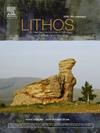印度南部达尔瓦克拉通新元古代Closepet岩浆岩的多级岩浆和后岩浆演化--从榍石的质地和化学成分中获得的启示
IF 2.5
2区 地球科学
Q2 GEOCHEMISTRY & GEOPHYSICS
引用次数: 0
摘要
榍石经常被用来描述火成岩、变质岩和热液过程的路径。因此,榍石可以揭示花岗岩的多阶段岩浆和后岩浆演化过程。在本研究中,我们全面研究了约2.57-2.51 Ga的近花岗岩。2.57-2.51 Ga的Closepet岩体进行了全面研究。这个花岗岩体提供了一个独特的机会,因为该浴成岩的各个构造层次都在不断出露。通过对榍石的质地和地球化学研究,并辅以 UPb 同位素测年,我们区分出了五代岩浆榍石和热液榍石。三类岩浆榍石显示了阶段性生长结晶(I 型),以及从还原、高温(II 型)到氧化、低温条件(III 型)的变化。热液榍石被记录为蚀变榍石,具有带状至斑块状纹理、次生断裂和细脉(类型 IV),以及生物榍石中的榍石包裹体(类型 V)。热液榍石(IV 型)显示稀土元素和高场强元素的贫化,表明这些元素被流体移动。用 LA-ICP-MS 对岩浆榍石 I 型进行 UPb 测定,得出的年龄约为 2.5 Ga,与 Closepet 浴岩的形成时间一致。榍石纹理与化学之间的关系表明,榍石是Closepet岩浆岩多阶段岩浆演化和后岩浆演化的记录者。此外,我们的研究还表明,热液活动影响了大片区域,流体在Closepet岩床的上部构造层中进行了长距离循环。本文章由计算机程序翻译,如有差异,请以英文原文为准。
Multistage magmatic and post-magmatic evolution of the Neoarchaean Closepet Batholith of Dharwar Craton in southern India - insights from the texture and chemical composition of titanite
Titanite is often used to describe the path of igneous, metamorphic, and hydrothermal processes. Therefore, titanite can unravel the multistage magmatic and post-magmatic evolution of granitoids. In this study, we present a comprehensive study of the ca. 2.57–2.51 Ga Closepet Batholith in the Dharwar Craton of southern India using titanite. This granitoid body provides a unique opportunity as various structural levels of the batholith are continuously outcropping. The textural and geochemical studies of titanite, supported by U![]() Pb isotopic dating, allowed us to distinguish five generations of magmatic and hydrothermal titanite. Three types of magmatic titanite demonstrate stage-growth crystallization (type I) and a change from reduced, high-temperature (type II) to oxidised, low-temperature conditions (type III). Hydrothermal titanite is recorded as altered titanite with zoned to patchy textures and secondary fractures and veinlets (type IV) and titanite inclusions within biotite (type V). Hydrothermal titanite (type IV) shows depletion in rare earth elements and high-field strength elements, indicating mobilization of those elements by a fluid. U
Pb isotopic dating, allowed us to distinguish five generations of magmatic and hydrothermal titanite. Three types of magmatic titanite demonstrate stage-growth crystallization (type I) and a change from reduced, high-temperature (type II) to oxidised, low-temperature conditions (type III). Hydrothermal titanite is recorded as altered titanite with zoned to patchy textures and secondary fractures and veinlets (type IV) and titanite inclusions within biotite (type V). Hydrothermal titanite (type IV) shows depletion in rare earth elements and high-field strength elements, indicating mobilization of those elements by a fluid. U![]() Pb dating by LA-ICP-MS of magmatic titanite type I yielded ages of ca. 2.5 Ga, consistent with the timing of formation of the Closepet Batholith. The relationship between titanite textures and chemistry indicates that titanite serves as a recorder of the multistage magmatic and post-magmatic evolution of the Closepet Batholith. In addition, our study shows that hydrothermal activity affected a large area, with fluids circulating over long distances within the upper structural levels of the Closepet Batholith.
Pb dating by LA-ICP-MS of magmatic titanite type I yielded ages of ca. 2.5 Ga, consistent with the timing of formation of the Closepet Batholith. The relationship between titanite textures and chemistry indicates that titanite serves as a recorder of the multistage magmatic and post-magmatic evolution of the Closepet Batholith. In addition, our study shows that hydrothermal activity affected a large area, with fluids circulating over long distances within the upper structural levels of the Closepet Batholith.
求助全文
通过发布文献求助,成功后即可免费获取论文全文。
去求助
来源期刊

Lithos
地学-地球化学与地球物理
CiteScore
6.80
自引率
11.40%
发文量
286
审稿时长
3.5 months
期刊介绍:
Lithos publishes original research papers on the petrology, geochemistry and petrogenesis of igneous and metamorphic rocks. Papers on mineralogy/mineral physics related to petrology and petrogenetic problems are also welcomed.
 求助内容:
求助内容: 应助结果提醒方式:
应助结果提醒方式:


